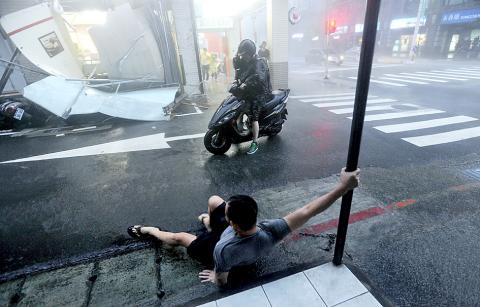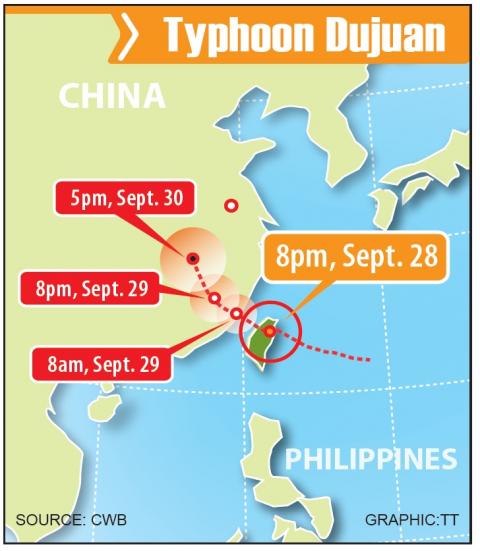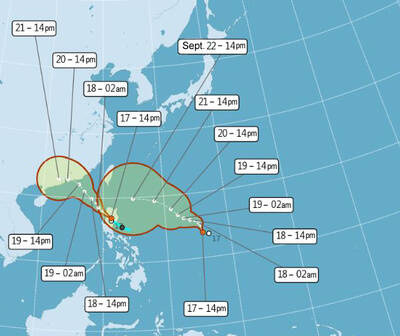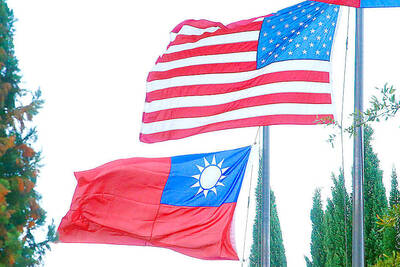More than 4,000 people were evacuated yesterday in areas of northern and eastern Taiwan as Typhoon Dujuan approached the nation, gathering strength as it bore down on the east coast.
The military, working with local governments, evacuated people from areas vulnerable to falling rocks, mudslides and flooding in 39 townships and districts in Yilan, Hualien, Taitung, Hsinchu and Nantou counties and Taipei and New Taipei City.
New Taipei City Mayor Eric Chu (朱立倫) said the vulnerable areas include Wulai District (烏來), which was hit hard by Typhoon Soudelor last month, with some residents unable to return home for weeks. Most shops and hotels in the hot springs town remain closed as roads and flood damage are yet to be fully repaired.

Photo: Hua Meng-ching, Taipei Times
“To be honest, we all feel very depressed. Any damage might further prolong the time needed for reconstruction,” said Chou Chih-kang, an Wulai neighborhood leader.
Television footage showed fast-moving flood waters swamping roads just outside Taipei and huge waves crashing against the northeast coastline.
Taipei 101 also reported that one of the glass doors to the underground portion of its mall was damaged by a strong gust of wind, but it had been repaired by the evening.

Photo: Lin Cheng-kung, Taipei Times
As of 7pm last night, the Central Emergency Operation Center said no injuries had been reported.
A total of 937,900 households nationwide lost power at some point during the day and as of 7:20pm, 532,800 households were still waiting for power to be restored, mostly in Yilan County and Taichung.
The Central Weather Bureau (CWB) said Dujuan made landfall at Suao Township (蘇澳) in Yilan County at 5:40pm. Suao brought gusts of wind reaching 243.7kph, the second-highest on record since a weather station was established in the township 34 years ago, the bureau said.

The strongest gusts ever experienced in Suao occurred during Typhoon Gladys in 1994, when wind speeds hit 246.9kph, the bureau said.
As of 9pm, the storm was centered 30km northeast of Taichung, moving at 20kph west-northwest, the bureau said.
With a radius of 220km, the storm’s strongest winds were estimated to be 184kph.
A super flood tide was due yesterday evening, and this, coupled with heavy tides brought by Dujuan, could inundate low-lying areas along the west coast of Taiwan proper, as well as riversides in the area.
Authorities said coastal areas could be particularly dangerous as tides are affected by the “supermoon” — a rare astrological event in which the moon appears brighter and larger — because it has reached its closest orbital point to Earth, resulting in its gravitational pull being stronger than usual.
According to the Ministry of National Defense, more than 24,000 personnel are on standby for disaster relief and evacuations, with 100 shelters set up.
At 8pm last night, Taipei, New Taipei City and Keelung had declared a half-typhoon day today, canceling work and classes this morning. However, at 10pm the three cities announced that the whole day would be a typhoon day.
Chuanghua, Nantou, Penghu, Yilan and Lienchiang counties and Taichung also declared a typhoon day for the full day. Taitung County and Tainan City are to operate as normal working days. Kaohsiung City, and Pingtung and Hualien Counties were yet to make announcements.
A Bon Jovi concert scheduled to take place last night at the Taipei World Trade Center Nangang Exhibition Hall was canceled because of the typhoon. The event promoter yesterday afternoon said that tickets for last night’s show could be exchanged or refunded at the exhibition hall starting at noon today. It also said that 90 percent of the tickets would be able to be exchanged.
The weather bureau said the typhoon would move away from Taiwan by noon today, but that rain and wind would only ease up after it made landfall in China.

Taiwan is projected to lose a working-age population of about 6.67 million people in two waves of retirement in the coming years, as the nation confronts accelerating demographic decline and a shortage of younger workers to take their place, the Ministry of the Interior said. Taiwan experienced its largest baby boom between 1958 and 1966, when the population grew by 3.78 million, followed by a second surge of 2.89 million between 1976 and 1982, ministry data showed. In 2023, the first of those baby boom generations — those born in the late 1950s and early 1960s — began to enter retirement, triggering

One of two tropical depressions that formed off Taiwan yesterday morning could turn into a moderate typhoon by the weekend, the Central Weather Administration (CWA) said yesterday. Tropical Depression No. 21 formed at 8am about 1,850km off the southeast coast, CWA forecaster Lee Meng-hsuan (李孟軒) said. The weather system is expected to move northwest as it builds momentum, possibly intensifying this weekend into a typhoon, which would be called Mitag, Lee said. The radius of the storm is expected to reach almost 200km, she said. It is forecast to approach the southeast of Taiwan on Monday next week and pass through the Bashi Channel

NO CHANGE: The TRA makes clear that the US does not consider the status of Taiwan to have been determined by WWII-era documents, a former AIT deputy director said The American Institute in Taiwan’s (AIT) comments that World War-II era documents do not determine Taiwan’s political status accurately conveyed the US’ stance, the US Department of State said. An AIT spokesperson on Saturday said that a Chinese official mischaracterized World War II-era documents as stating that Taiwan was ceded to the China. The remarks from the US’ de facto embassy in Taiwan drew criticism from the Ma Ying-jeou Foundation, whose director said the comments put Taiwan in danger. The Chinese-language United Daily News yesterday reported that a US State Department spokesperson confirmed the AIT’s position. They added that the US would continue to

The number of Chinese spouses applying for dependent residency as well as long-term residency in Taiwan has decreased, the Mainland Affairs Council said yesterday, adding that the reduction of Chinese spouses staying or living in Taiwan is only one facet reflecting the general decrease in the number of people willing to get married in Taiwan. The number of Chinese spouses applying for dependent residency last year was 7,123, down by 2,931, or 29.15 percent, from the previous year. The same census showed that the number of Chinese spouses applying for long-term residency and receiving approval last year stood at 2,973, down 1,520,